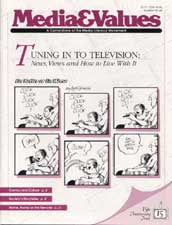EDITORIAL: Living With Television: Where Do We Go From Here?
|
This article originally appeared in Issue# 59-60
|
By Elizabeth Thoman
Any reader who has or even glanced through the previous 39 pages of this magazine can hardly fail to be impressed with the wealth of thinking, action suggestions and reflections that represent the best of our television criticism and analysis over the past 15 years.
As activities and commentary, they stand alone. But as a means of actually dealing with the impact of TV in our lives, the articles in this issue are barely a beginning. Just thinking or reading about television is only the first step toward media literacy. True media literacy results primarily from a process in which the media-aware individual moves along a continuum from criticism to empowerment.
This progression culminates in the ability to question not just the media one hears and sees, but the system that produces them as well. Media-literate television consumers, for example, recognize that television supports itself not so much by advertising products to viewers, but by selling viewer time to advertisers. We call it "renting eyeballs." But they also understand that in a democratic society the challenge to change such a system requires changing the way we all watch and use TV. To move from passive to interactive and aware consumers will be a "small step" for each person, but a giant leap for humankind.
Ultimately, this awareness has far-reaching implications. But such revolutionary consciousness doesn't come easily. And it is particularly hard to achieve when dealing with television because we take our "friend in the living room" so much for granted.
As longtime media theorist and researcher George Gerbner, dean emeritus of the Annenberg School for Communication/University of Pennsylvania, said recently, "Taking a close look at television is like looking at your neighborhood. It's so familiar you can't really see it. To 'see' it differently, you need a different perspective, like getting in a plane and flying over it."
TV Alert: A Wake-up Guide to Television Literacy, the latest CML Media Literacy Workshop Kit™, is designed to further our "flyover" look at television. Using the established principles of media literacy education, it provides process-oriented activities to become more television-literate  around issues like TV violence, stereotyping, sexuality, the news and more. Its eight learning modules provide a catalyst for teachers, group leaders, even concerned parents, searching for tools to help people challenge - and change - the impact of television in their day-to-day lives.
around issues like TV violence, stereotyping, sexuality, the news and more. Its eight learning modules provide a catalyst for teachers, group leaders, even concerned parents, searching for tools to help people challenge - and change - the impact of television in their day-to-day lives.
With its interactive, workshop-centered process, this Kit continues our series of practical yet exciting workshop kits for promoting media literacy education on a variety of media-related subjects.
But this method for media literacy didn't arise casually. Based initially on the principles of activist educator Paulo Freire, it was strongly influenced by English media theorist Len Masterman and other leaders of the worldwide media education movement.
Indeed, one of our most exciting discoveries of the past few years was just that: we are not alone. From Scotland to Australia, Toulouse to Manila, we've discovered a world of educators struggling to define and shape both our personal and communal relationships with media.The media literacy movement in the United States is also growing, and the Center for Media Literacy is on the leading edge of that growth.
It's clear that whatever the new millennium brings, media, and especially television, will continue to be a vehicle for human interaction. But will that interaction be active or passive? Will television be our servant or our ruler? Will it become a true window on the world, or will it remain the shill selling us a bill of goods? Will it help heal the world … or destroy it?
The media literacy movement can help us all develop positive answers to these questions.



